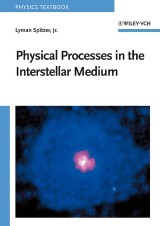Details

Physical Processes in the Interstellar Medium
1. Aufl.
|
99,99 € |
|
| Verlag: | Wiley-VCH |
| Format: | |
| Veröffentl.: | 20.11.2008 |
| ISBN/EAN: | 9783527617739 |
| Sprache: | englisch |
| Anzahl Seiten: | 335 |
DRM-geschütztes eBook, Sie benötigen z.B. Adobe Digital Editions und eine Adobe ID zum Lesen.
Beschreibungen
Discusses the nature of interstellar matter, with a strong emphasis on basic physical principles. Summarizes the present state of knowledge about the interstellar medium and provides the latest observational data. Physics and chemistry of the interstellar medium are treated, with frequent references to observational results. The overall equilibrium and dynamical state of the interstellar gas are described, with discussions of explosions produced by star birth and star death and the initial phases of cloud collapse leading to star formation.
Interstellar Matter-- An Overview.<br> <br> Elastic Collisions and Kinetic Equilibrium.<br> <br> Radiative Processes.<br> <br> Excitation.<br> <br> Ionization and Dissociation.<br> <br> Kinetic Temperature.<br> <br> Optical Properties of Grains.<br> <br> Polarization and Grain Alignment.<br> <br> Physical Properties of Grains.<br> <br> Dynamical Principles.<br> <br> Overall Equilibrium.<br> <br> Explosive Motions.<br> <br> Gravitational Motion.<br> <br> Symbols.<br> <br> Index.
Lyman Spitzer, Jr. studied at Yale and Cambridge Universities and earned his Ph.D. under Henry Norris Russell at Princeton University. Following research at Harvard, teaching at Yale, and war work in New York, Spitzer succeeded Russell as professor and observatory director at Princeton in 1947. He promptly hired Martin Schwarzschild, with whom he built a major research department. Spitzer worked in many areas of theoretical astrophysics, including spectral line formation, the dynamical evolution of star clusters, and star formation. His most important work was on the physics of the interstellar medium. He showed that there must be at least two phases - high temperature clouds around hot stars and cooler intercloud regions, and led in studies of interstellar dust grains and magnetic fields. Spitzer was the first to propose a large telescope in space (in 1946) - he was analyzing data from the Hubble Space Telescope the day he died. He led the development and operation of the ultraviolet astronomy satellite Copernicus. An early leader in attempts to harness controlled thermonuclear fusion on earth, he was the founder and first director of the Princeton<br> Plasma Physics Laboratory (originally called Project Matterhorn). Lyman Spitzer, Jr., died in 1997. One of NASA's four Great Observatories is named the Spitzer Space Telescope in his memory.

















